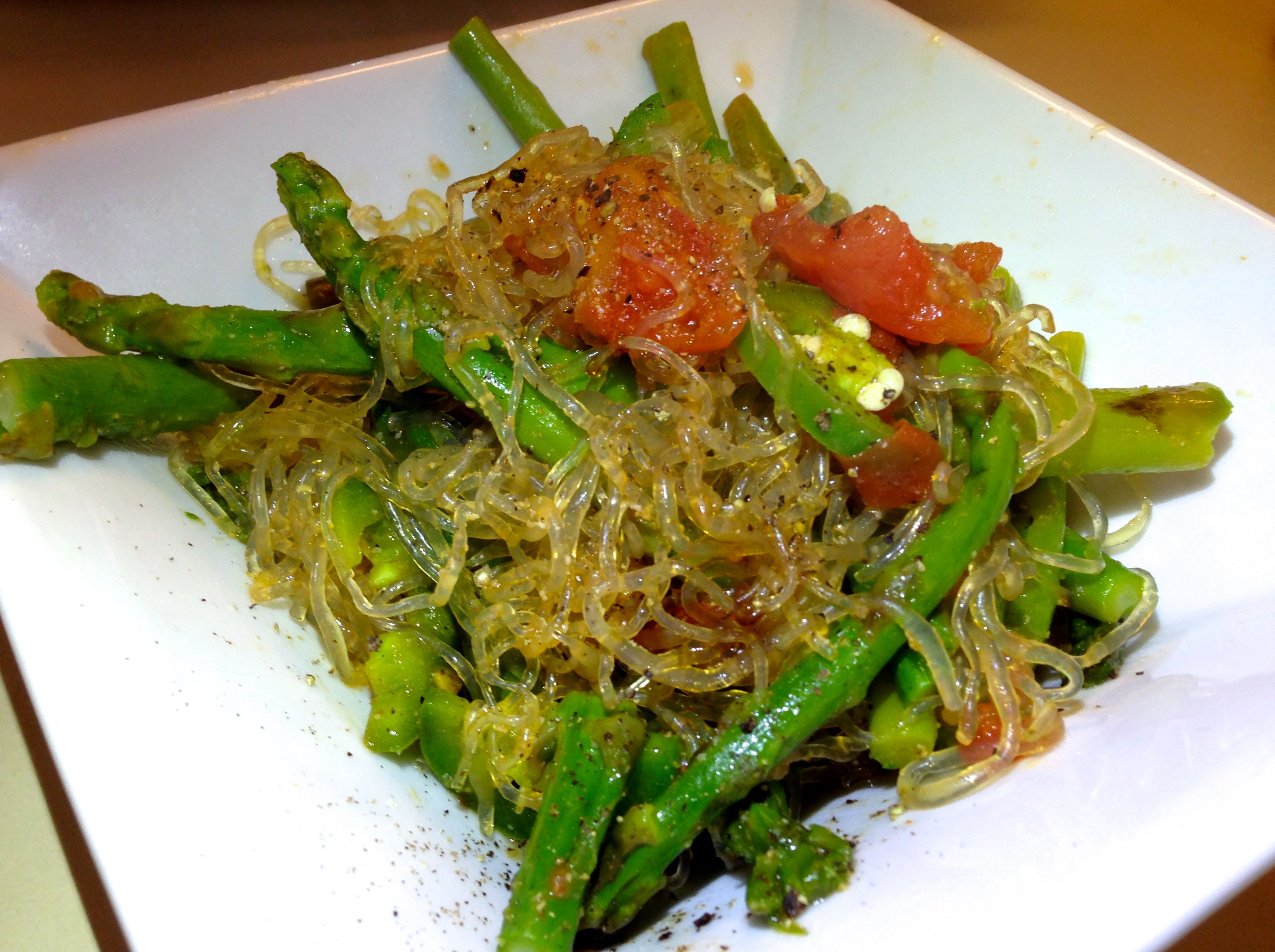Kelp Noodles

I have come a long way in my acceptance and transition back to the world of pasta… well, at least to the word “noodle” itself. Self acclaimed pasta-holic that I am, I have mentioned and confessed my addiction many times along this vegan blog journey. I feared the word pasta or noodle even up to my very recent zucchini noodle blog. To recap quickly, the recipe called for both zucchini and kelp noodles, but I didn’t care what the non-vegetable noodle was made of- from soy to mung bean to even kelp- I wasn’t falling for it. As I researched a bit, I found no nutritional or emotional damage would be made from the kelp noodles. I admitted that I would give them a try and today is the day!
Kelp noodles are made from water, kelp and sodium alginate. Kelp is classified as a brown sea vegetable like some of the other algae or seaweeds. Kelp noodles have many properties which may make a nice addition to anyone’s diet especially those interested in weight loss or raw foods:
- No fat or cholesterol
- Very low in calories; about 15 calories per portion size and 45 calories total in the entire bag
- Gluten-free for those with sensitivities
- (No protein and very little fiber) – please keep in mind that suggested fiber intakes for women range between 25-35 grams daily and 35-45 grams daily for men.
- Powerhouse source of the mineral Iodine. Iodine is necessary for proper thyroid function and metabolism. Too much Iodine is equally problematic. (see quote below)
- Kelp satisfies 15% of the RDA for calcium and 4% for iron. If you eat the whole bag like I did, that’s almost 50% of the calcium levels needed in one meal.
- Rich in the mineral vanadium, which works with enzymes to produce a highly antioxidant defense for the body
- Contains lignans which act as phytoestrogens and antioxidants
- Contains sulfated polysaccharides called fucoidans which are known to reduce inflammation and pain. (see quote below)
- Good source of vitamin K and folate
- “Kelp works as a blood purifier, relieves arthritis stiffness, and promotes adrenal, pituitary and thyroid health.” Retrieved from Safety of Herbal Supplements & Health Articles/ What Are Sea Vegetables? http://www.healthyhealing.com/herbs-articles-safety/bid/175220/What-Are-Sea-Vegetables
- Kelp and sea vegetables in general also have many other minerals, trace elements and enzymes which function together for optimum health
I prepared these noodles today from a pasta perspective, however, I am excited to try them in raw dishes. On my to-do list now that I am a fan of these kelp noodles are:
- A raw noodle dish with sesame oil, shoyu and brown rice vinegar- perhaps even spicy.
- Miso soup with tofu, mushrooms and kelp noodles
- A combination of these noodles with spiraled zucchini noodles prepared Italian style
- Pad Thai– I’m so excited! I have been thinking about this old favorite of mine for years!
- Coconut flavored noodles (raw) with slivered coconut meat from fresh young Thai coconuts
- Salad sensations– I want to create a whole new array of salads with these noodles throw in.
This is purely an example of “Reinventing Indulgence”. The sky is the limit with these noodles and even if someone indulges, it won’t be too horrific like a major pasta binge which may call for an intervention. (Thinking of my own personal experiences here).
REMEMBER:
Rinse these noodles well and then let them soak in warm water to soften them up a bit if that is the texture you are looking for. They can also be marinaded for those who want to prepare a raw experience. If you are cooking them, they will automatically soften up.
First I steamed some asparagus that I had on hand. You can choose any vegetable and switch it up. Next, and separately, I was in the mood for a spicy and flavorful sauté so I started with coconut oil and jalapeños – fresh! I added some cut garden tomatoes and then the kelp noodles. I added the steamed asparagus to the kelp noodles, stirred, served and indulged!
Iodine information
“Sea vegetables may be a unique food source not only of the mineral iodine, but also of the mineral vanadium. As part of their natural defense mechanisms, sea vegetables contain a variety of enzymes called haloperoxidases. These enzymes all require vanadium in order to function. Although this mineral is not as well known as some of the other mineral nutrients, it appears to play a multi-faceted role in regulation of carbohydrate metabolism and blood sugar. While research in this area is still in the preliminary stage and remains mixed in terms of results, vanadium may help to increase our body’s sensitivity to insulin by inhibiting a group of enzymes called protein tyrosine phosphatases. It may also help us decrease our body’s production of glucose and help us increase our body’s ability to store starch in the form of glycogen.” Retrieved from the World’s Healthiest Foods: http://www.whfoods.com/genpage.php?tname=foodspice&dbid=135
Sulfated polysaccharides called fucodans
“Sea vegetables also contain a unique group of polysaccharides called fucoidans. These fucoidans have a characteristic branching pattern with sulfur containing molecules. They are being widely studied for their ability to reduce inflammation within the body. These sulfated fucoidans have been shown to reduce pain, fight viruses and prevent atherosclerosis.” Retrieved from Natural News: http://www.naturalnews.com/034055_sea_vegetables_kelp.html
Learn more:
http://www.naturalnews.com/025816_kelp_food_health.html
Disclaimer: The information given here is for educational purposes only. You should not use this to diagnose or treat a health problem or disease without consulting with a qualified health care provider.

Love kelp noodles! Where do you get yours?
Hi Erena! I used SEA TANGLE! I bought mine in a health food store but they are much cheaper online by the case. http://www.kelpnoodles.com/products_seatangle_noodles.html